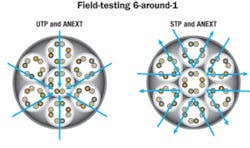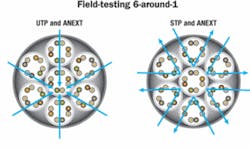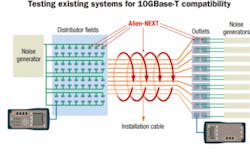Another perspective on 10GBase-T, alien interference
As standard specifications develop, users need to be concerned with accuracy levels, alien interference outside of cable bundles, and practical field-test procedures.
The theme of the year in the LAN cabling business is an application that will increase the data rate in networks tenfold: 10-Gigabit Ethernet. The system of fiber-optic cables (IEEE 802.3ae) as backbone, which has been in operation for quite a while, is now ready to spread out horizontally to the next stage.
The IEEE 802.3an transmission standard specifies 10-Gigabit Ethernet data transfer via twisted-pair copper cable. Even with the 802.3ab 1-Gbit/sec Ethernet protocol, it was obvious how important it was to reach the individual workplace so that a transmission standard would gain widespread adoption.
In addition to the standard’s theoretical base, it is of equally vital importance to provide the capacity to operate over available cabling systems. That being the case, much attention has been focused on transmitting 10GBase-T on existing Class E/Category 6 systems with a 250-MHz bandwidth. But because the requirements for 10GBase-T exceeded Class E/Category 6’s available bandwidth, the specifications for LAN cabling would have to be redefined.
New challenges
The present proposals for resetting the new ISO Class EA and ISO Class FA standards for Europe, and Category 6A for the North American market, are the subject of hot debate. Current ISO Class E and Category 6 standards were due to run out slightly more than four years from now; the new norms will definitely reduce this schedule considerably. Field-testing equipment, naturally, will be affected by these changes.
The most obvious innovation is the extension of the frequency to be tested. Detailed studies have shown that the existing upper-limit frequency of 250 MHz is no longer sufficient for transmitting 10GBase-T with any certainty. Initial estimates that a new 625-MHz frequency limit was necessary have since been adjusted to 500 MHz. The limit values themselves should be interpolated; i.e., extended Class E/Category 6 limit value curves that can be adapted to the new specifications with only a few minor adjustments. The 8-pin modular RJ-45 interface up to 500 MHz will keep its function as connecting hardware. The new Class FA specification will mean that the frequency range for Class F will be raised from the present 600 MHz to 1,000 MHz.
Standardized TERA and GG-45 connectors are already capable of fulfilling the targeted extra requirements for the transmission links. But because the only players in this “league” are shielded systems with high-performance bandwidth, let’s go back to take a closer look at the Class E/Category 6 level.
The new classes described earlier also present new challenges for field-testing technology. Every owner of a LAN cable tester will face the question of whether to make another investment in a new measuring instrument. The answer is: Maybe. It all boils down to the tester you have been using.
One thing, however, is clear: Category 6 channel-testing equipment with Level III accuracy is no longer a suitable runner in this race.
The most striking change in field measurement is the broadening of the frequency range. For Category 6A and ISO Class EA, the frequency range goes up to 500 MHz. For ISO Class FA, the test range increases to a formidable 1,000 MHz. Upgrading the measuring range does not necessarily lead to a new definition of measurement accuracy.
While devices with Level III accuracy were standard to previous measurements up to 250 MHz, the new Category 6A/Class EA measurements will require a new accuracy level: Level IIIe. For ISO Class FA, there will be a corresponding Level IVe definition-a further development of the existing Level IV accuracy category for measurements up to 600 MHz. It is worth noting here that the accuracy categories Level IV and Level IVe are “downwardly compatible” to Level IIIe. In practice, this means that every current Level IV Class F/Category 7 testing device is already suitable for measurements according to Category 6A and ISO Class EA.
Are there any more bad tidings for field test equipment? The answer this time around is quite simple: No. Of course, the odd marginal value will change to accommodate the later function of the 10-Gigabit Ethernet application. This will cause only minor software headaches when it comes to programming in the respective correct threshold value curves. Manufacturers of field-testing technology will conform to the changes in standardization by providing corresponding firmware updates for their equipment.
New measurement parameters for acceptance tests with field-measuring devices are not foreseen in the standardization for Category 6A and Class EA channels. A current hot topic is the measurements of a new source of irritation that is causing headaches, to the unshielded world in particular: At frequencies around 300 MHz and above, the individual transmission channels begin to interfere with each other. This effect is known as alien crosstalk (AXT), and it occurs not in the cable links themselves between the wire pairs, but from cable to cable.
The alien dilemma
The level of unwanted signals generally depends on the geometric structure of the system; in other words, the type of disturbing frames, data outlets, data-grade cables, and cable touting along the cable runs. The new parameters derived from this effect are alien NEXT and alien FEXT-ANEXT and AFEXT-and their power-sum values. These parameters define the crosstalk from neighboring cable runs on one cable and, under certain circumstances, play a significant role in the application of 10-Gigabit Ethernet via unshielded copper wires.
As it has not yet been possible to effectively measure these parameters in the field, due to the complexity of the disturbance, the problem can be solved another way. As previously described in the case of reference parameters, determining the values is transferred to the laboratory.
The latest plans on this subject foresee a standardized test setup. This method is known as the “6-around-1” method and involves creating a link with a central cable and six interferers. In other words, a total of seven equal-length links are connected to each other at previously defined distances. Every circuit is now measured against the others, so that altogether, there are 96 individual measurements.
The rationale behind this test method is to simulate a repeatable worst-case scenario. The key word here is “repeatable,” because ANEXT is an extremely transient being. The slightest alteration in the test setup’s geometric structure will also change the effect on ANEXT. For example, a change in the cable positioning, connection components, or the patch cables will cause a change in the test values. The 6-around-1 test method is a good way to test a worst-case maximum value, as it accurately reflects the maximum expected disturbance of the links, or cable, to each other. Anything that occurs later in practice can, therefore, only have a weaker-and potentially much weaker-influence.
For measurements in the field, however, the 6-around-1 test setups are practically useless, because permanently installed cabling almost never is laid exactly in that geometry.
As a practical matter, it is important to look at another unpleasant effect: Electromagnetic waves from outside the cable bundle. Negative sources in a building are not restricted to data cables, but rather, can come from hundreds of other electromagnetic sources in or near the building-including air conditioning, electric motors, electric cables, transmitter masts, microwave ovens, telephones, and personal computers. Even the weather can play a role.
Measurements in the field, then, are dependent on daily changing situations, and so are not easily repeatable. They can vary widely depending on how many negative external noise sources are switched on or are in the vicinity at the time. If, for example, a normal office block is tested on a weekend, the tests will yield different values from those obtained in the middle of a weekday because, in most offices, the majority of electrical appliances are switched off during the weekend, and the air conditioning is either off or running on low.
When field-testing, you also need to consider the influence of all data cables on each other. This requires an extremely complex and time-consuming series of measurements. A test series for ANEXT is several dimensions greater in complexity than simple Class E/Category 6 or Class F/Category 7 measurements with handheld meters. At a time when technicians are already working under excessive cost pressure, this would lead to an unacceptable burden in terms of time and money.
A strategy for field measurements
Standardization offers real support by taking the matter out of the technician’s hands. The solution to the ANEXT problem is to define an appropriate interference resistance for Category 6A products so that, at least in the context of ANEXT and associated electrical characteristics, a smooth 10-GbE operation in the field is guaranteed.
When cables, panels, connectors, and patch cords are resistant to ANEXT from the word “go,” it no longer will be necessary to verify this effect in the field.
For existing unshielded system, standardization will define special cases. For legacy unshielded Category 6 networks, there are two standard designs for establishing the efficiency of 10-GbE operation:
• The TIA/EIA has developed Telecommunications Systems Bulletin TSB-155, the function of which is to analyze cabling links that are already in place.
• ISO/IEC TR24750 is a technical report that is to be used for measuring existing Class E systems.
Additionally, standards groups will examine special cases in which alien crosstalk has little relevance due to the length of the cabling; however, it remains to be seen to what extent these theoretical special cases are meaningful in practice. It is also worth noting that in the standardization process, so far, there has been no agreement on the test setup for field measurements.
It is equally important to be aware that, under the current circumstances, manufacturers can only guarantee 10-GbE capability for the entire channel because specifications for components and permanent links are still under development. The mix-and-match interoperability idea that exists all the way up to Category 6 cannot be applied here-yet.
It’s important to pay close attention to the cabling manufacturer’s instructions for the individual components that are to be used. Shielded components will have an easier time meeting performance requirements, as the shield offers adequate protection against ANEXT.
Coming into focus
Creation of the Category 6A and the Class EA and FA specifications is moving forward. This progress raises hope that, for field-testing standards, at least, there will soon be some sort of clarity about what to do and what not to do.
But one thing is apparent: Testers capable of testing 500 MHz or more, fulfilling Level IV accuracy specifications, are well-equipped to face this new challenge.Editor’s note: This is the latest of three articles, written by three different manufacturers of test equipment, on the topic of testing 10GBase-T-capable UTP systems. We encourage you to read the previously published articles “Testing guidelines for 10-GbE over twisted pairs,” (September 2006, page 36) and “Rethinking field testing for alien crosstalk,” (February 2006, page 12) for a more comprehensive look at the strategies and recommendations of different test-equipment manufacturers concerning field testing the latest-generation UTP cabling systems.
KONSTANTIN HUEDEPOHL is marketing manager and ALFRED HUBER is technical support and service manager with Ideal Industries (www.idealindustries.com). Huedepohl is an active member of the standardization panels for DKE 715.3.2 and IEC TC46WG9.


